Cloud Computing, Security Requirements and Networking in Organisations
VerifiedAdded on 2023/06/11
|11
|3337
|328
Report
AI Summary
This report examines the role of technology in organizations, focusing on cloud computing, security, and networking infrastructure, using Amazon as a case study. It discusses cloud computing service models (IaaS, PaaS, SaaS) and their benefits, including cost savings, enhanced security, and improved quality control. The report also outlines three crucial security requirements: security awareness training, change management policies, and password management policies, explaining how these frameworks help organizations control and secure their data. Furthermore, it briefly touches on Amazon's networking infrastructure, highlighting the scale and considerations involved in managing large data centers. Desklib provides access to this report and other solved assignments for students.
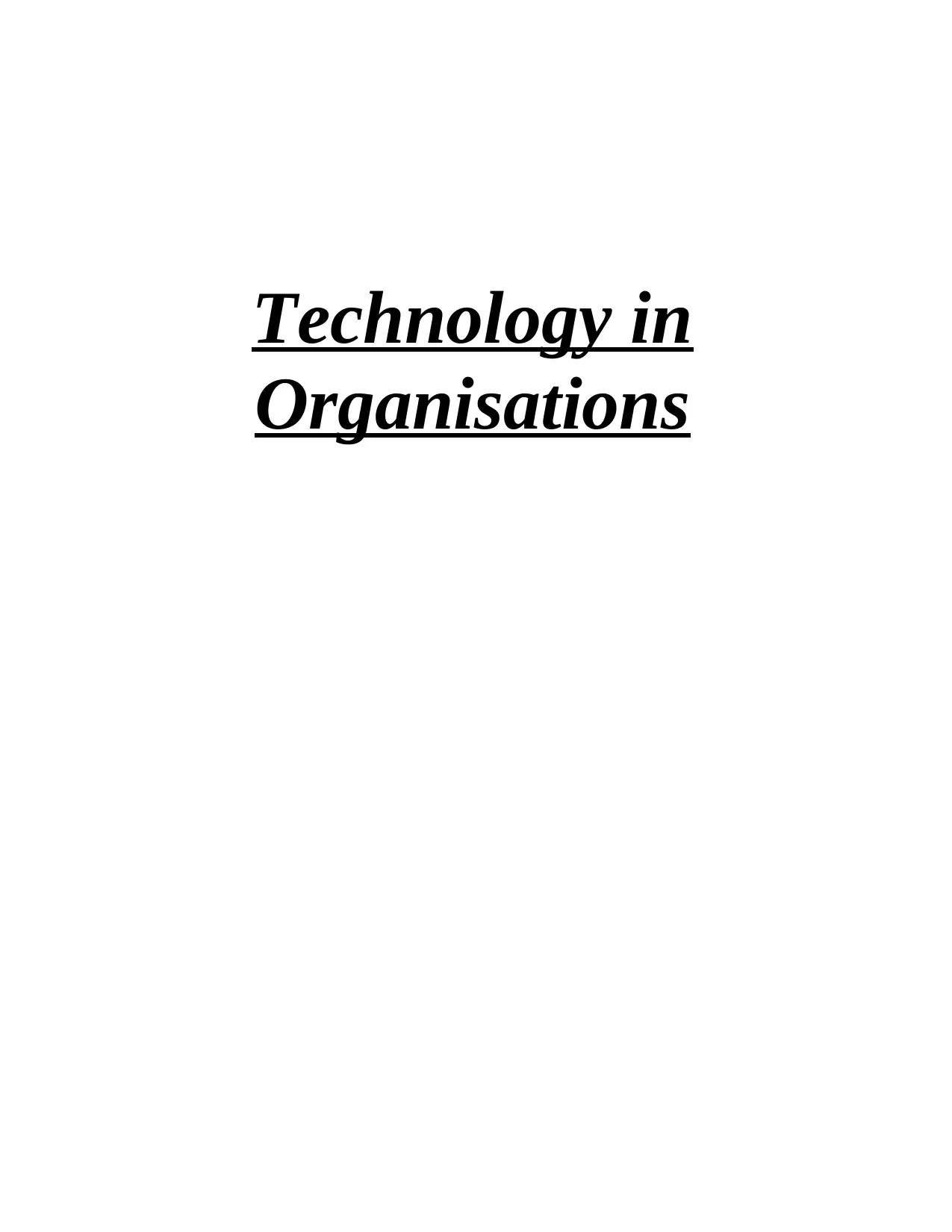
Technology in
Organisations
Organisations
Paraphrase This Document
Need a fresh take? Get an instant paraphrase of this document with our AI Paraphraser
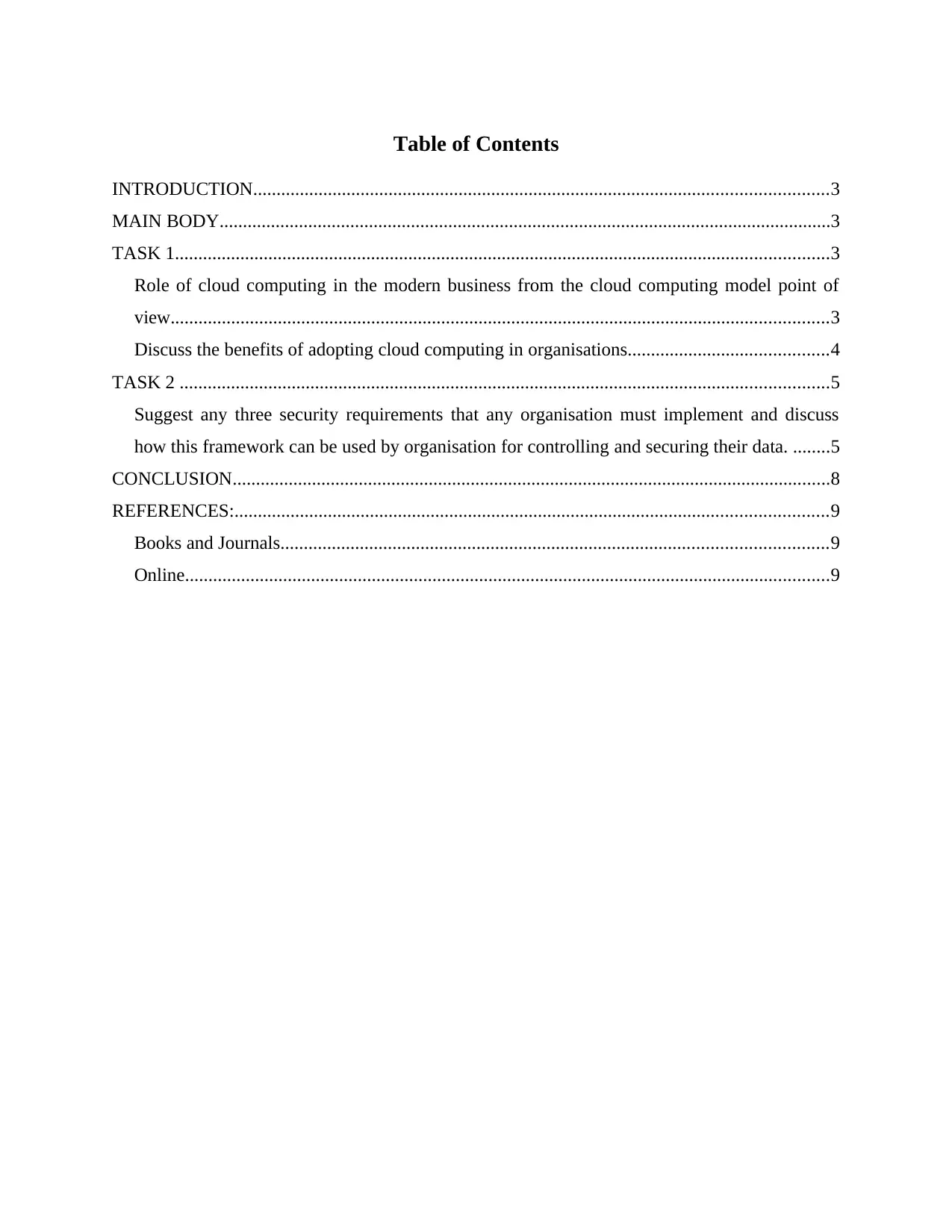
Table of Contents
INTRODUCTION...........................................................................................................................3
MAIN BODY...................................................................................................................................3
TASK 1............................................................................................................................................3
Role of cloud computing in the modern business from the cloud computing model point of
view.............................................................................................................................................3
Discuss the benefits of adopting cloud computing in organisations...........................................4
TASK 2 ...........................................................................................................................................5
Suggest any three security requirements that any organisation must implement and discuss
how this framework can be used by organisation for controlling and securing their data. ........5
CONCLUSION................................................................................................................................8
REFERENCES:...............................................................................................................................9
Books and Journals.....................................................................................................................9
Online..........................................................................................................................................9
INTRODUCTION...........................................................................................................................3
MAIN BODY...................................................................................................................................3
TASK 1............................................................................................................................................3
Role of cloud computing in the modern business from the cloud computing model point of
view.............................................................................................................................................3
Discuss the benefits of adopting cloud computing in organisations...........................................4
TASK 2 ...........................................................................................................................................5
Suggest any three security requirements that any organisation must implement and discuss
how this framework can be used by organisation for controlling and securing their data. ........5
CONCLUSION................................................................................................................................8
REFERENCES:...............................................................................................................................9
Books and Journals.....................................................................................................................9
Online..........................................................................................................................................9
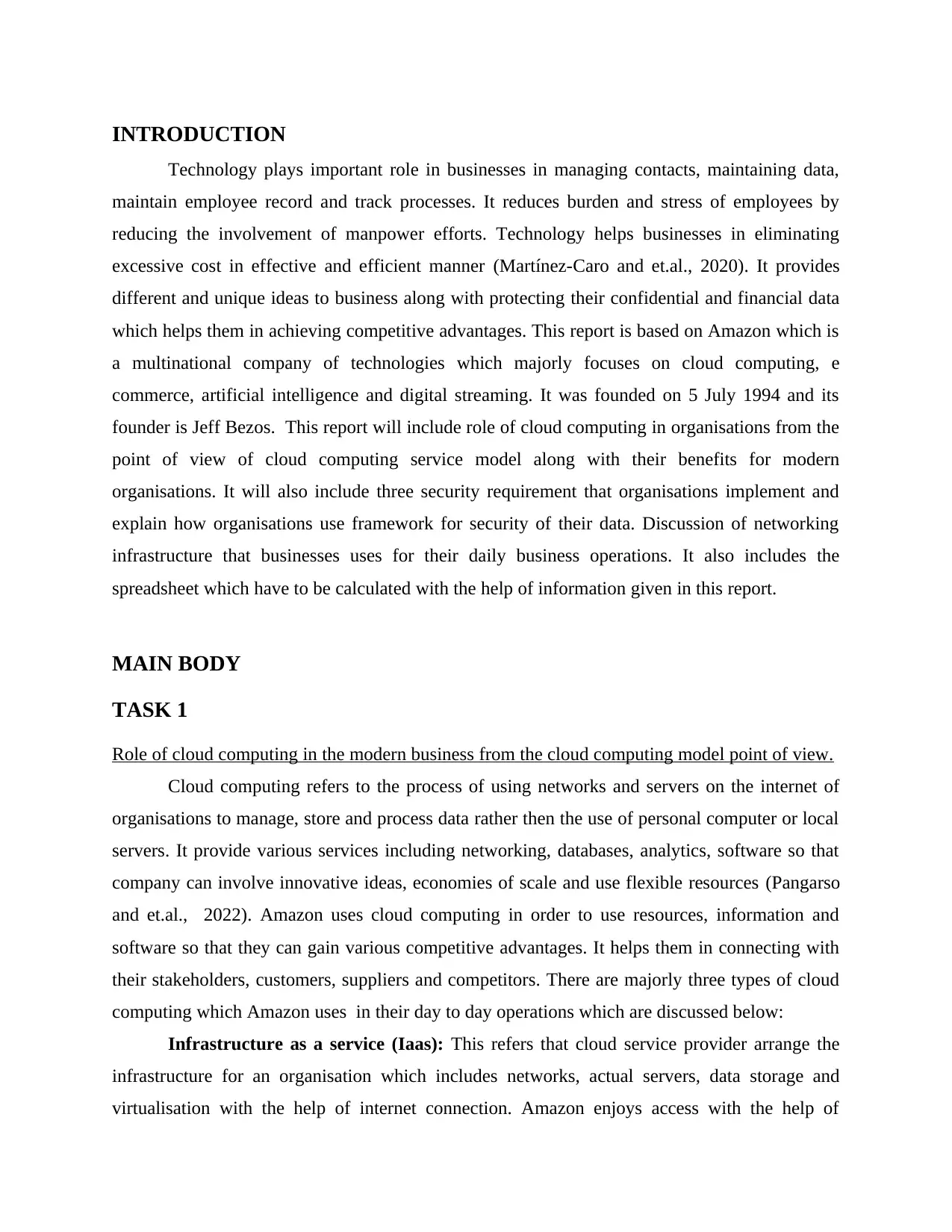
INTRODUCTION
Technology plays important role in businesses in managing contacts, maintaining data,
maintain employee record and track processes. It reduces burden and stress of employees by
reducing the involvement of manpower efforts. Technology helps businesses in eliminating
excessive cost in effective and efficient manner (Martínez-Caro and et.al., 2020). It provides
different and unique ideas to business along with protecting their confidential and financial data
which helps them in achieving competitive advantages. This report is based on Amazon which is
a multinational company of technologies which majorly focuses on cloud computing, e
commerce, artificial intelligence and digital streaming. It was founded on 5 July 1994 and its
founder is Jeff Bezos. This report will include role of cloud computing in organisations from the
point of view of cloud computing service model along with their benefits for modern
organisations. It will also include three security requirement that organisations implement and
explain how organisations use framework for security of their data. Discussion of networking
infrastructure that businesses uses for their daily business operations. It also includes the
spreadsheet which have to be calculated with the help of information given in this report.
MAIN BODY
TASK 1
Role of cloud computing in the modern business from the cloud computing model point of view.
Cloud computing refers to the process of using networks and servers on the internet of
organisations to manage, store and process data rather then the use of personal computer or local
servers. It provide various services including networking, databases, analytics, software so that
company can involve innovative ideas, economies of scale and use flexible resources (Pangarso
and et.al., 2022). Amazon uses cloud computing in order to use resources, information and
software so that they can gain various competitive advantages. It helps them in connecting with
their stakeholders, customers, suppliers and competitors. There are majorly three types of cloud
computing which Amazon uses in their day to day operations which are discussed below:
Infrastructure as a service (Iaas): This refers that cloud service provider arrange the
infrastructure for an organisation which includes networks, actual servers, data storage and
virtualisation with the help of internet connection. Amazon enjoys access with the help of
Technology plays important role in businesses in managing contacts, maintaining data,
maintain employee record and track processes. It reduces burden and stress of employees by
reducing the involvement of manpower efforts. Technology helps businesses in eliminating
excessive cost in effective and efficient manner (Martínez-Caro and et.al., 2020). It provides
different and unique ideas to business along with protecting their confidential and financial data
which helps them in achieving competitive advantages. This report is based on Amazon which is
a multinational company of technologies which majorly focuses on cloud computing, e
commerce, artificial intelligence and digital streaming. It was founded on 5 July 1994 and its
founder is Jeff Bezos. This report will include role of cloud computing in organisations from the
point of view of cloud computing service model along with their benefits for modern
organisations. It will also include three security requirement that organisations implement and
explain how organisations use framework for security of their data. Discussion of networking
infrastructure that businesses uses for their daily business operations. It also includes the
spreadsheet which have to be calculated with the help of information given in this report.
MAIN BODY
TASK 1
Role of cloud computing in the modern business from the cloud computing model point of view.
Cloud computing refers to the process of using networks and servers on the internet of
organisations to manage, store and process data rather then the use of personal computer or local
servers. It provide various services including networking, databases, analytics, software so that
company can involve innovative ideas, economies of scale and use flexible resources (Pangarso
and et.al., 2022). Amazon uses cloud computing in order to use resources, information and
software so that they can gain various competitive advantages. It helps them in connecting with
their stakeholders, customers, suppliers and competitors. There are majorly three types of cloud
computing which Amazon uses in their day to day operations which are discussed below:
Infrastructure as a service (Iaas): This refers that cloud service provider arrange the
infrastructure for an organisation which includes networks, actual servers, data storage and
virtualisation with the help of internet connection. Amazon enjoys access with the help of
⊘ This is a preview!⊘
Do you want full access?
Subscribe today to unlock all pages.

Trusted by 1+ million students worldwide
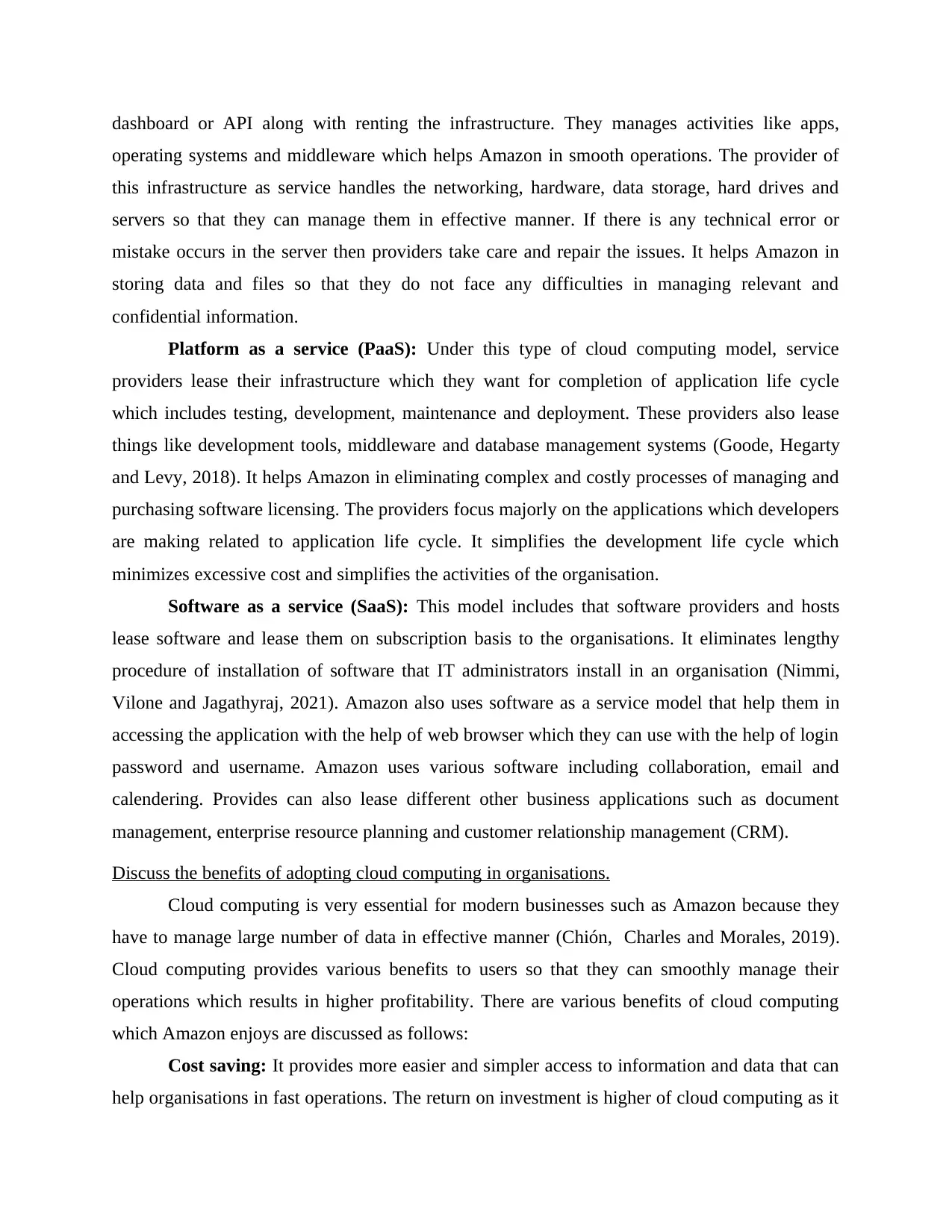
dashboard or API along with renting the infrastructure. They manages activities like apps,
operating systems and middleware which helps Amazon in smooth operations. The provider of
this infrastructure as service handles the networking, hardware, data storage, hard drives and
servers so that they can manage them in effective manner. If there is any technical error or
mistake occurs in the server then providers take care and repair the issues. It helps Amazon in
storing data and files so that they do not face any difficulties in managing relevant and
confidential information.
Platform as a service (PaaS): Under this type of cloud computing model, service
providers lease their infrastructure which they want for completion of application life cycle
which includes testing, development, maintenance and deployment. These providers also lease
things like development tools, middleware and database management systems (Goode, Hegarty
and Levy, 2018). It helps Amazon in eliminating complex and costly processes of managing and
purchasing software licensing. The providers focus majorly on the applications which developers
are making related to application life cycle. It simplifies the development life cycle which
minimizes excessive cost and simplifies the activities of the organisation.
Software as a service (SaaS): This model includes that software providers and hosts
lease software and lease them on subscription basis to the organisations. It eliminates lengthy
procedure of installation of software that IT administrators install in an organisation (Nimmi,
Vilone and Jagathyraj, 2021). Amazon also uses software as a service model that help them in
accessing the application with the help of web browser which they can use with the help of login
password and username. Amazon uses various software including collaboration, email and
calendering. Provides can also lease different other business applications such as document
management, enterprise resource planning and customer relationship management (CRM).
Discuss the benefits of adopting cloud computing in organisations.
Cloud computing is very essential for modern businesses such as Amazon because they
have to manage large number of data in effective manner (Chión, Charles and Morales, 2019).
Cloud computing provides various benefits to users so that they can smoothly manage their
operations which results in higher profitability. There are various benefits of cloud computing
which Amazon enjoys are discussed as follows:
Cost saving: It provides more easier and simpler access to information and data that can
help organisations in fast operations. The return on investment is higher of cloud computing as it
operating systems and middleware which helps Amazon in smooth operations. The provider of
this infrastructure as service handles the networking, hardware, data storage, hard drives and
servers so that they can manage them in effective manner. If there is any technical error or
mistake occurs in the server then providers take care and repair the issues. It helps Amazon in
storing data and files so that they do not face any difficulties in managing relevant and
confidential information.
Platform as a service (PaaS): Under this type of cloud computing model, service
providers lease their infrastructure which they want for completion of application life cycle
which includes testing, development, maintenance and deployment. These providers also lease
things like development tools, middleware and database management systems (Goode, Hegarty
and Levy, 2018). It helps Amazon in eliminating complex and costly processes of managing and
purchasing software licensing. The providers focus majorly on the applications which developers
are making related to application life cycle. It simplifies the development life cycle which
minimizes excessive cost and simplifies the activities of the organisation.
Software as a service (SaaS): This model includes that software providers and hosts
lease software and lease them on subscription basis to the organisations. It eliminates lengthy
procedure of installation of software that IT administrators install in an organisation (Nimmi,
Vilone and Jagathyraj, 2021). Amazon also uses software as a service model that help them in
accessing the application with the help of web browser which they can use with the help of login
password and username. Amazon uses various software including collaboration, email and
calendering. Provides can also lease different other business applications such as document
management, enterprise resource planning and customer relationship management (CRM).
Discuss the benefits of adopting cloud computing in organisations.
Cloud computing is very essential for modern businesses such as Amazon because they
have to manage large number of data in effective manner (Chión, Charles and Morales, 2019).
Cloud computing provides various benefits to users so that they can smoothly manage their
operations which results in higher profitability. There are various benefits of cloud computing
which Amazon enjoys are discussed as follows:
Cost saving: It provides more easier and simpler access to information and data that can
help organisations in fast operations. The return on investment is higher of cloud computing as it
Paraphrase This Document
Need a fresh take? Get an instant paraphrase of this document with our AI Paraphraser
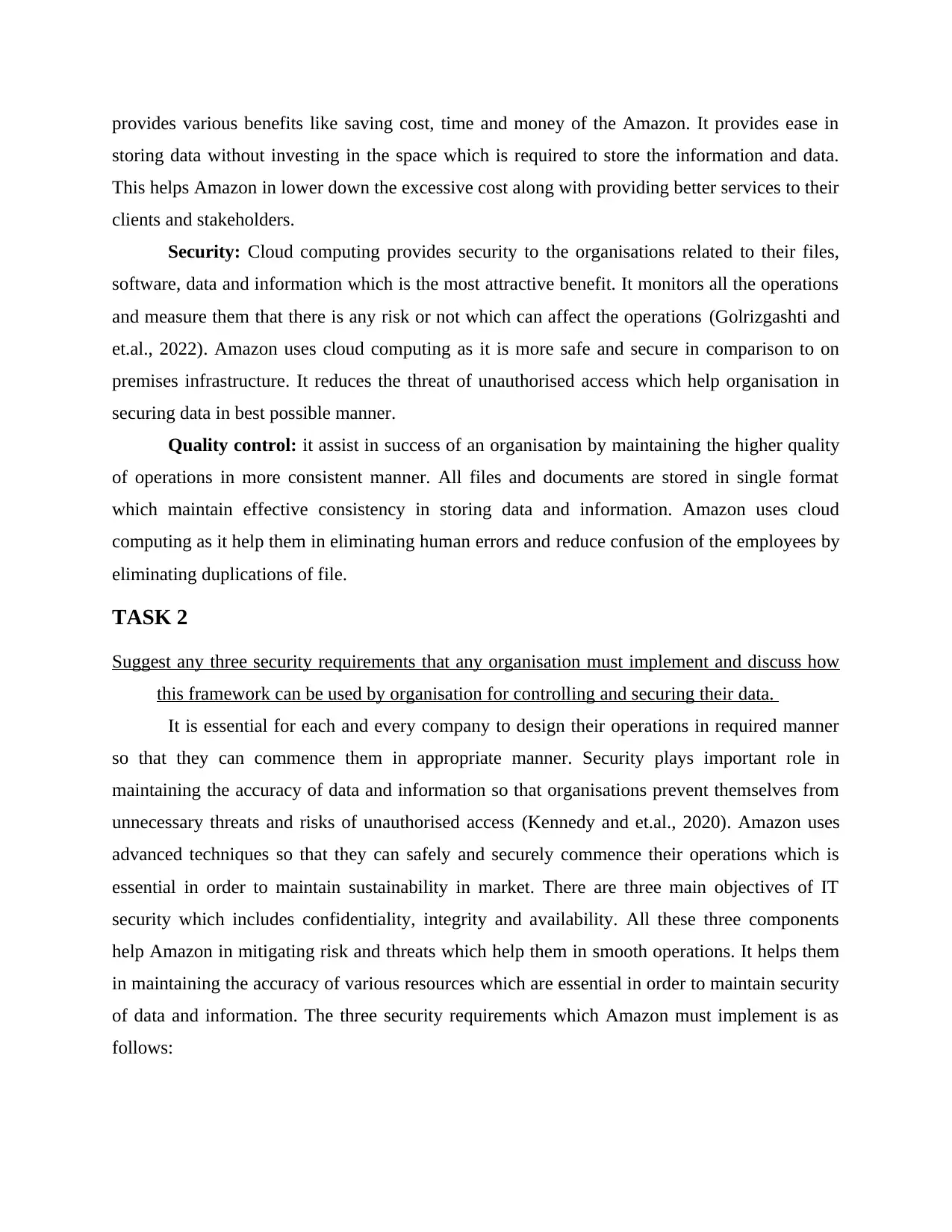
provides various benefits like saving cost, time and money of the Amazon. It provides ease in
storing data without investing in the space which is required to store the information and data.
This helps Amazon in lower down the excessive cost along with providing better services to their
clients and stakeholders.
Security: Cloud computing provides security to the organisations related to their files,
software, data and information which is the most attractive benefit. It monitors all the operations
and measure them that there is any risk or not which can affect the operations (Golrizgashti and
et.al., 2022). Amazon uses cloud computing as it is more safe and secure in comparison to on
premises infrastructure. It reduces the threat of unauthorised access which help organisation in
securing data in best possible manner.
Quality control: it assist in success of an organisation by maintaining the higher quality
of operations in more consistent manner. All files and documents are stored in single format
which maintain effective consistency in storing data and information. Amazon uses cloud
computing as it help them in eliminating human errors and reduce confusion of the employees by
eliminating duplications of file.
TASK 2
Suggest any three security requirements that any organisation must implement and discuss how
this framework can be used by organisation for controlling and securing their data.
It is essential for each and every company to design their operations in required manner
so that they can commence them in appropriate manner. Security plays important role in
maintaining the accuracy of data and information so that organisations prevent themselves from
unnecessary threats and risks of unauthorised access (Kennedy and et.al., 2020). Amazon uses
advanced techniques so that they can safely and securely commence their operations which is
essential in order to maintain sustainability in market. There are three main objectives of IT
security which includes confidentiality, integrity and availability. All these three components
help Amazon in mitigating risk and threats which help them in smooth operations. It helps them
in maintaining the accuracy of various resources which are essential in order to maintain security
of data and information. The three security requirements which Amazon must implement is as
follows:
storing data without investing in the space which is required to store the information and data.
This helps Amazon in lower down the excessive cost along with providing better services to their
clients and stakeholders.
Security: Cloud computing provides security to the organisations related to their files,
software, data and information which is the most attractive benefit. It monitors all the operations
and measure them that there is any risk or not which can affect the operations (Golrizgashti and
et.al., 2022). Amazon uses cloud computing as it is more safe and secure in comparison to on
premises infrastructure. It reduces the threat of unauthorised access which help organisation in
securing data in best possible manner.
Quality control: it assist in success of an organisation by maintaining the higher quality
of operations in more consistent manner. All files and documents are stored in single format
which maintain effective consistency in storing data and information. Amazon uses cloud
computing as it help them in eliminating human errors and reduce confusion of the employees by
eliminating duplications of file.
TASK 2
Suggest any three security requirements that any organisation must implement and discuss how
this framework can be used by organisation for controlling and securing their data.
It is essential for each and every company to design their operations in required manner
so that they can commence them in appropriate manner. Security plays important role in
maintaining the accuracy of data and information so that organisations prevent themselves from
unnecessary threats and risks of unauthorised access (Kennedy and et.al., 2020). Amazon uses
advanced techniques so that they can safely and securely commence their operations which is
essential in order to maintain sustainability in market. There are three main objectives of IT
security which includes confidentiality, integrity and availability. All these three components
help Amazon in mitigating risk and threats which help them in smooth operations. It helps them
in maintaining the accuracy of various resources which are essential in order to maintain security
of data and information. The three security requirements which Amazon must implement is as
follows:

Security awareness and training policy: This policy administered all the members of an
organisation that they should work effectively along with safeguarding the relevant information
of their company. Amazon provide training to their employees which involves the confidentiality
agreement which help them in effectively completion of the training. This agreement can be used
as the proof of training which help employees in understanding the work environment in better
manner (Hong and et.al., 2022). Amazon design policies and strategies which their employees
have to follow in order to maintain the security and confidentiality. Training helps Amazon in
providing knowledge and education to their employees so that they know how to secure data.
Security awareness trainings help employees in understanding the designed policy which assist
them in completion of task in desired manner. Changes which are expected in technology should
be conducted during the time of training so that employees can better understand the criteria of
safety and security of data. The training and policies should cover all the relevant aspects so that
employees know how to perform in required manner. Factors like internet access policies,
maintaining proper workstations, employee responsibilities for usage of computer security
should be covered in training of the employees.
Change management policy: Organisation should properly manage the changes which
are related to information system which helps in proper regulation of the operations. The major
focus of this policy is to approve, manage and track the operations for the appropriate
management. Software and system can be altered and replaced because of different reasons
which can affect the operations and security of an organisation (Globocnik, Rauter and
Baumgartner, 2020). Amazon also uses this policy which eliminates the unexpected changes
which can negatively affect the security. Correct planning and implementation of policies should
be carried out by managers so that they can maintain consistency in the changing environment.
Changes which are related to IT sector must follow proper and consistent structure so that
organisation can maintain uniformity in their operations. Changes should be implemented in
positive manner which results in higher security and safety of the confidential information and
data.
Password creation and management policy: This policy helps organisation in guiding
on how the operations should be created, executed and reviewed which help them in proper
documentation procedure. In order to safeguard the documents, information, files and data, it is
necessary to create and change passwords so that organisation protect them from risk. Amazon
organisation that they should work effectively along with safeguarding the relevant information
of their company. Amazon provide training to their employees which involves the confidentiality
agreement which help them in effectively completion of the training. This agreement can be used
as the proof of training which help employees in understanding the work environment in better
manner (Hong and et.al., 2022). Amazon design policies and strategies which their employees
have to follow in order to maintain the security and confidentiality. Training helps Amazon in
providing knowledge and education to their employees so that they know how to secure data.
Security awareness trainings help employees in understanding the designed policy which assist
them in completion of task in desired manner. Changes which are expected in technology should
be conducted during the time of training so that employees can better understand the criteria of
safety and security of data. The training and policies should cover all the relevant aspects so that
employees know how to perform in required manner. Factors like internet access policies,
maintaining proper workstations, employee responsibilities for usage of computer security
should be covered in training of the employees.
Change management policy: Organisation should properly manage the changes which
are related to information system which helps in proper regulation of the operations. The major
focus of this policy is to approve, manage and track the operations for the appropriate
management. Software and system can be altered and replaced because of different reasons
which can affect the operations and security of an organisation (Globocnik, Rauter and
Baumgartner, 2020). Amazon also uses this policy which eliminates the unexpected changes
which can negatively affect the security. Correct planning and implementation of policies should
be carried out by managers so that they can maintain consistency in the changing environment.
Changes which are related to IT sector must follow proper and consistent structure so that
organisation can maintain uniformity in their operations. Changes should be implemented in
positive manner which results in higher security and safety of the confidential information and
data.
Password creation and management policy: This policy helps organisation in guiding
on how the operations should be created, executed and reviewed which help them in proper
documentation procedure. In order to safeguard the documents, information, files and data, it is
necessary to create and change passwords so that organisation protect them from risk. Amazon
⊘ This is a preview!⊘
Do you want full access?
Subscribe today to unlock all pages.

Trusted by 1+ million students worldwide
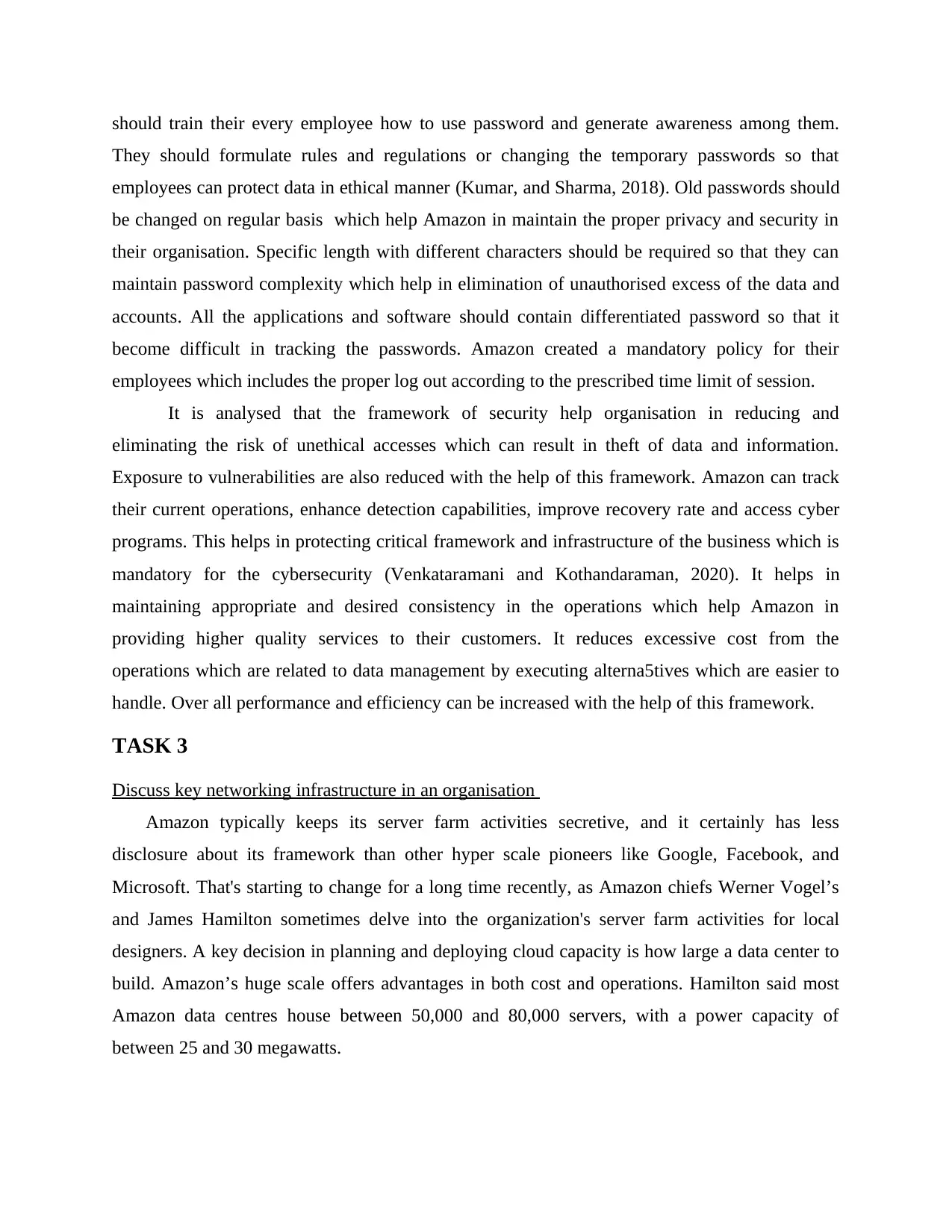
should train their every employee how to use password and generate awareness among them.
They should formulate rules and regulations or changing the temporary passwords so that
employees can protect data in ethical manner (Kumar, and Sharma, 2018). Old passwords should
be changed on regular basis which help Amazon in maintain the proper privacy and security in
their organisation. Specific length with different characters should be required so that they can
maintain password complexity which help in elimination of unauthorised excess of the data and
accounts. All the applications and software should contain differentiated password so that it
become difficult in tracking the passwords. Amazon created a mandatory policy for their
employees which includes the proper log out according to the prescribed time limit of session.
It is analysed that the framework of security help organisation in reducing and
eliminating the risk of unethical accesses which can result in theft of data and information.
Exposure to vulnerabilities are also reduced with the help of this framework. Amazon can track
their current operations, enhance detection capabilities, improve recovery rate and access cyber
programs. This helps in protecting critical framework and infrastructure of the business which is
mandatory for the cybersecurity (Venkataramani and Kothandaraman, 2020). It helps in
maintaining appropriate and desired consistency in the operations which help Amazon in
providing higher quality services to their customers. It reduces excessive cost from the
operations which are related to data management by executing alterna5tives which are easier to
handle. Over all performance and efficiency can be increased with the help of this framework.
TASK 3
Discuss key networking infrastructure in an organisation
Amazon typically keeps its server farm activities secretive, and it certainly has less
disclosure about its framework than other hyper scale pioneers like Google, Facebook, and
Microsoft. That's starting to change for a long time recently, as Amazon chiefs Werner Vogel’s
and James Hamilton sometimes delve into the organization's server farm activities for local
designers. A key decision in planning and deploying cloud capacity is how large a data center to
build. Amazon’s huge scale offers advantages in both cost and operations. Hamilton said most
Amazon data centres house between 50,000 and 80,000 servers, with a power capacity of
between 25 and 30 megawatts.
They should formulate rules and regulations or changing the temporary passwords so that
employees can protect data in ethical manner (Kumar, and Sharma, 2018). Old passwords should
be changed on regular basis which help Amazon in maintain the proper privacy and security in
their organisation. Specific length with different characters should be required so that they can
maintain password complexity which help in elimination of unauthorised excess of the data and
accounts. All the applications and software should contain differentiated password so that it
become difficult in tracking the passwords. Amazon created a mandatory policy for their
employees which includes the proper log out according to the prescribed time limit of session.
It is analysed that the framework of security help organisation in reducing and
eliminating the risk of unethical accesses which can result in theft of data and information.
Exposure to vulnerabilities are also reduced with the help of this framework. Amazon can track
their current operations, enhance detection capabilities, improve recovery rate and access cyber
programs. This helps in protecting critical framework and infrastructure of the business which is
mandatory for the cybersecurity (Venkataramani and Kothandaraman, 2020). It helps in
maintaining appropriate and desired consistency in the operations which help Amazon in
providing higher quality services to their customers. It reduces excessive cost from the
operations which are related to data management by executing alterna5tives which are easier to
handle. Over all performance and efficiency can be increased with the help of this framework.
TASK 3
Discuss key networking infrastructure in an organisation
Amazon typically keeps its server farm activities secretive, and it certainly has less
disclosure about its framework than other hyper scale pioneers like Google, Facebook, and
Microsoft. That's starting to change for a long time recently, as Amazon chiefs Werner Vogel’s
and James Hamilton sometimes delve into the organization's server farm activities for local
designers. A key decision in planning and deploying cloud capacity is how large a data center to
build. Amazon’s huge scale offers advantages in both cost and operations. Hamilton said most
Amazon data centres house between 50,000 and 80,000 servers, with a power capacity of
between 25 and 30 megawatts.
Paraphrase This Document
Need a fresh take? Get an instant paraphrase of this document with our AI Paraphraser
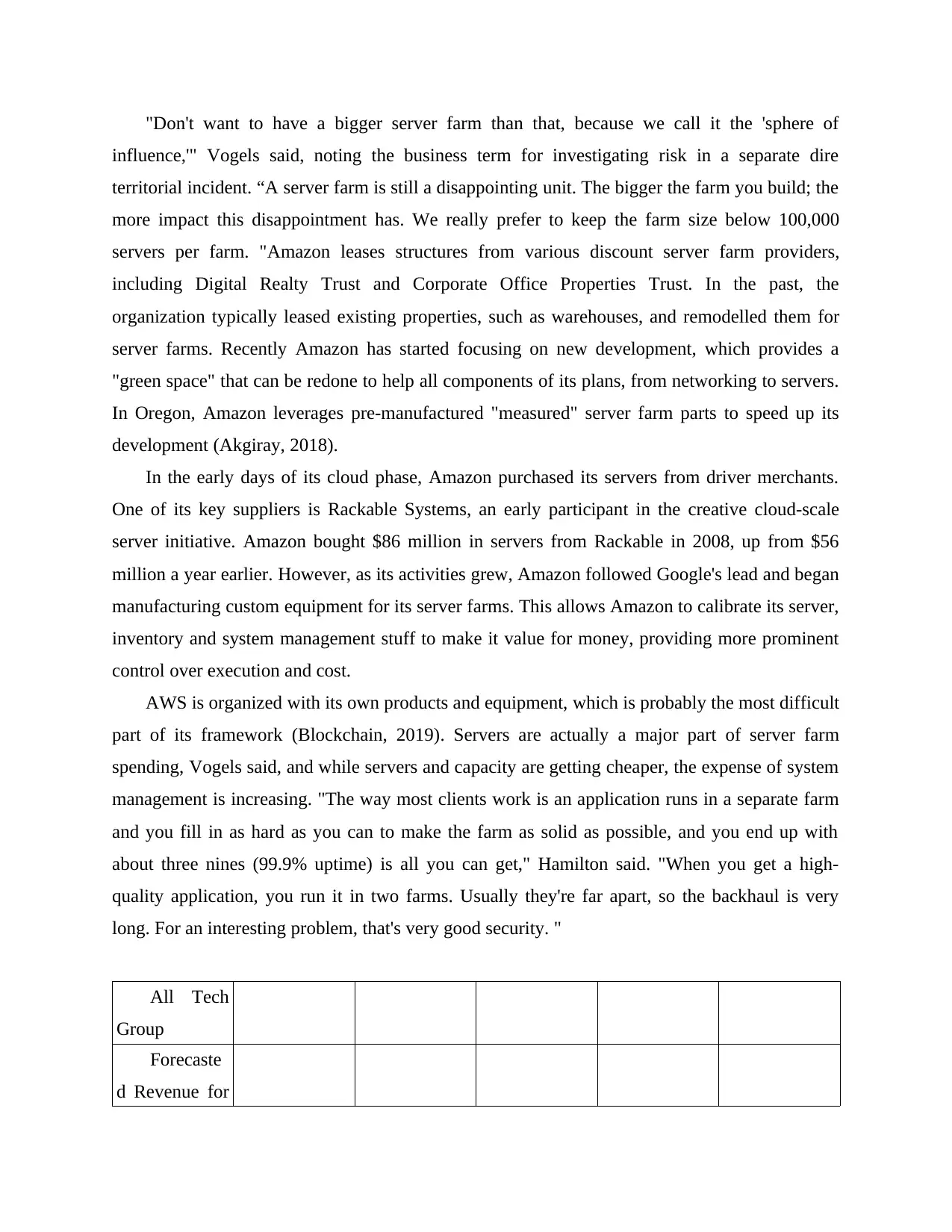
"Don't want to have a bigger server farm than that, because we call it the 'sphere of
influence,'" Vogels said, noting the business term for investigating risk in a separate dire
territorial incident. “A server farm is still a disappointing unit. The bigger the farm you build; the
more impact this disappointment has. We really prefer to keep the farm size below 100,000
servers per farm. "Amazon leases structures from various discount server farm providers,
including Digital Realty Trust and Corporate Office Properties Trust. In the past, the
organization typically leased existing properties, such as warehouses, and remodelled them for
server farms. Recently Amazon has started focusing on new development, which provides a
"green space" that can be redone to help all components of its plans, from networking to servers.
In Oregon, Amazon leverages pre-manufactured "measured" server farm parts to speed up its
development (Akgiray, 2018).
In the early days of its cloud phase, Amazon purchased its servers from driver merchants.
One of its key suppliers is Rackable Systems, an early participant in the creative cloud-scale
server initiative. Amazon bought $86 million in servers from Rackable in 2008, up from $56
million a year earlier. However, as its activities grew, Amazon followed Google's lead and began
manufacturing custom equipment for its server farms. This allows Amazon to calibrate its server,
inventory and system management stuff to make it value for money, providing more prominent
control over execution and cost.
AWS is organized with its own products and equipment, which is probably the most difficult
part of its framework (Blockchain, 2019). Servers are actually a major part of server farm
spending, Vogels said, and while servers and capacity are getting cheaper, the expense of system
management is increasing. "The way most clients work is an application runs in a separate farm
and you fill in as hard as you can to make the farm as solid as possible, and you end up with
about three nines (99.9% uptime) is all you can get," Hamilton said. "When you get a high-
quality application, you run it in two farms. Usually they're far apart, so the backhaul is very
long. For an interesting problem, that's very good security. "
All Tech
Group
Forecaste
d Revenue for
influence,'" Vogels said, noting the business term for investigating risk in a separate dire
territorial incident. “A server farm is still a disappointing unit. The bigger the farm you build; the
more impact this disappointment has. We really prefer to keep the farm size below 100,000
servers per farm. "Amazon leases structures from various discount server farm providers,
including Digital Realty Trust and Corporate Office Properties Trust. In the past, the
organization typically leased existing properties, such as warehouses, and remodelled them for
server farms. Recently Amazon has started focusing on new development, which provides a
"green space" that can be redone to help all components of its plans, from networking to servers.
In Oregon, Amazon leverages pre-manufactured "measured" server farm parts to speed up its
development (Akgiray, 2018).
In the early days of its cloud phase, Amazon purchased its servers from driver merchants.
One of its key suppliers is Rackable Systems, an early participant in the creative cloud-scale
server initiative. Amazon bought $86 million in servers from Rackable in 2008, up from $56
million a year earlier. However, as its activities grew, Amazon followed Google's lead and began
manufacturing custom equipment for its server farms. This allows Amazon to calibrate its server,
inventory and system management stuff to make it value for money, providing more prominent
control over execution and cost.
AWS is organized with its own products and equipment, which is probably the most difficult
part of its framework (Blockchain, 2019). Servers are actually a major part of server farm
spending, Vogels said, and while servers and capacity are getting cheaper, the expense of system
management is increasing. "The way most clients work is an application runs in a separate farm
and you fill in as hard as you can to make the farm as solid as possible, and you end up with
about three nines (99.9% uptime) is all you can get," Hamilton said. "When you get a high-
quality application, you run it in two farms. Usually they're far apart, so the backhaul is very
long. For an interesting problem, that's very good security. "
All Tech
Group
Forecaste
d Revenue for
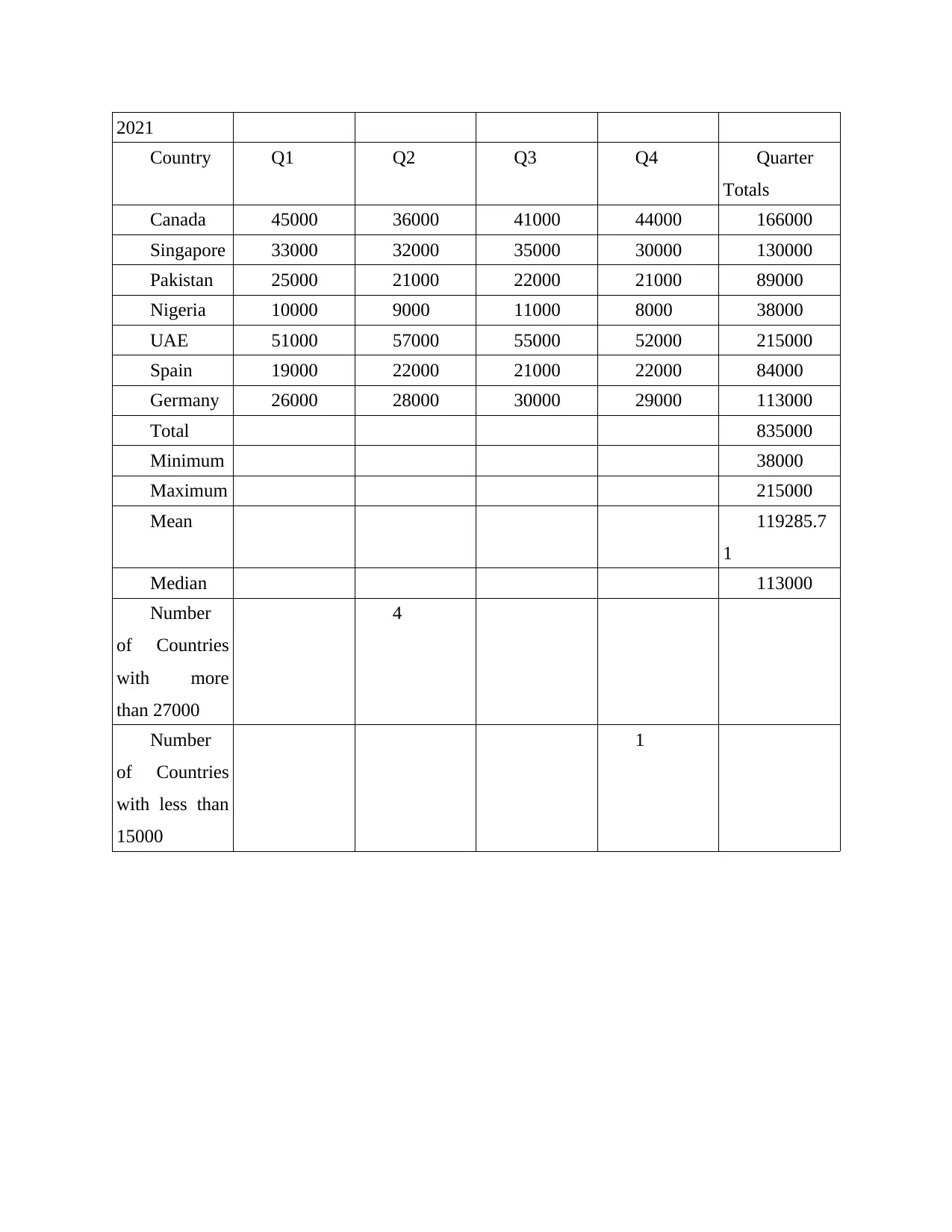
2021
Country Q1 Q2 Q3 Q4 Quarter
Totals
Canada 45000 36000 41000 44000 166000
Singapore 33000 32000 35000 30000 130000
Pakistan 25000 21000 22000 21000 89000
Nigeria 10000 9000 11000 8000 38000
UAE 51000 57000 55000 52000 215000
Spain 19000 22000 21000 22000 84000
Germany 26000 28000 30000 29000 113000
Total 835000
Minimum 38000
Maximum 215000
Mean 119285.7
1
Median 113000
Number
of Countries
with more
than 27000
4
Number
of Countries
with less than
15000
1
Country Q1 Q2 Q3 Q4 Quarter
Totals
Canada 45000 36000 41000 44000 166000
Singapore 33000 32000 35000 30000 130000
Pakistan 25000 21000 22000 21000 89000
Nigeria 10000 9000 11000 8000 38000
UAE 51000 57000 55000 52000 215000
Spain 19000 22000 21000 22000 84000
Germany 26000 28000 30000 29000 113000
Total 835000
Minimum 38000
Maximum 215000
Mean 119285.7
1
Median 113000
Number
of Countries
with more
than 27000
4
Number
of Countries
with less than
15000
1
⊘ This is a preview!⊘
Do you want full access?
Subscribe today to unlock all pages.

Trusted by 1+ million students worldwide
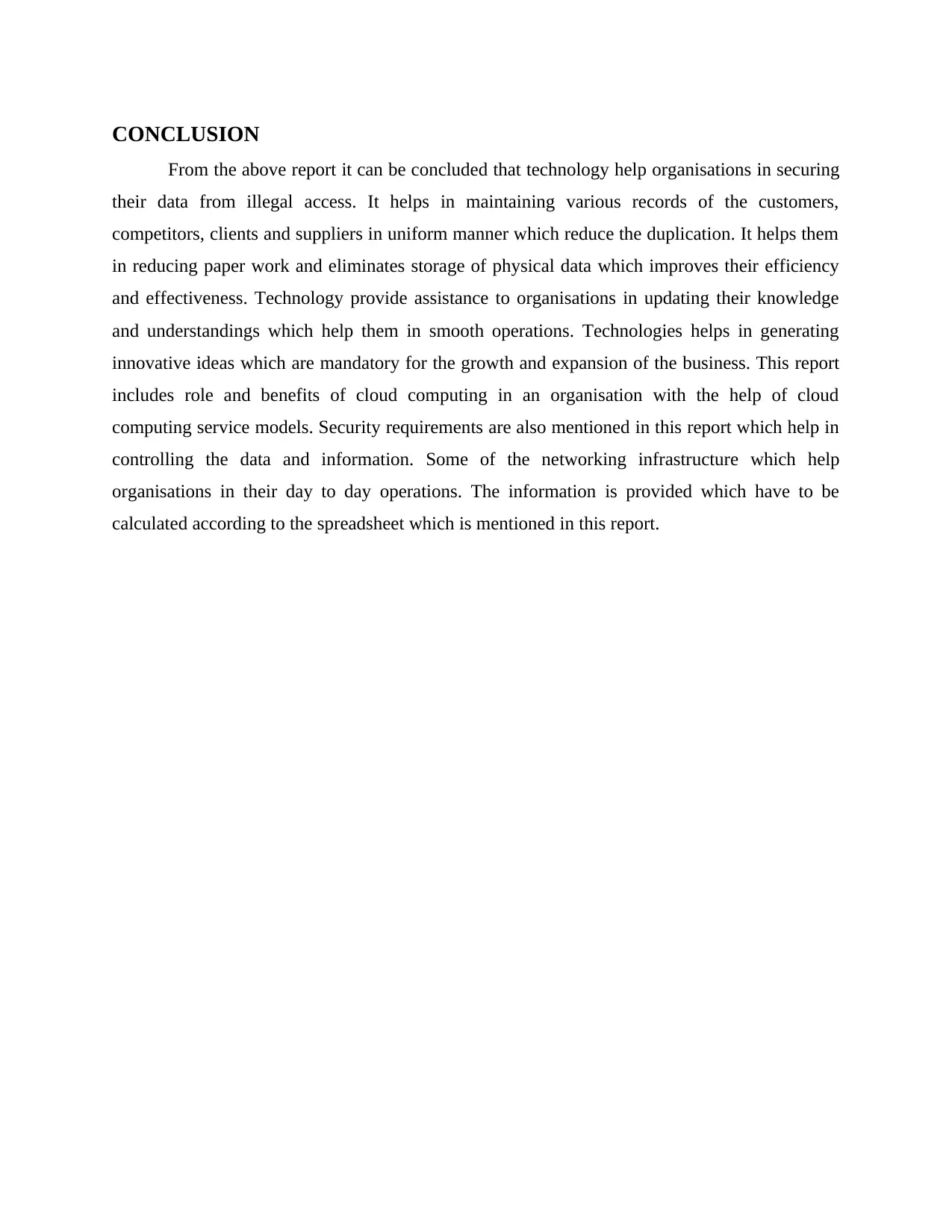
CONCLUSION
From the above report it can be concluded that technology help organisations in securing
their data from illegal access. It helps in maintaining various records of the customers,
competitors, clients and suppliers in uniform manner which reduce the duplication. It helps them
in reducing paper work and eliminates storage of physical data which improves their efficiency
and effectiveness. Technology provide assistance to organisations in updating their knowledge
and understandings which help them in smooth operations. Technologies helps in generating
innovative ideas which are mandatory for the growth and expansion of the business. This report
includes role and benefits of cloud computing in an organisation with the help of cloud
computing service models. Security requirements are also mentioned in this report which help in
controlling the data and information. Some of the networking infrastructure which help
organisations in their day to day operations. The information is provided which have to be
calculated according to the spreadsheet which is mentioned in this report.
From the above report it can be concluded that technology help organisations in securing
their data from illegal access. It helps in maintaining various records of the customers,
competitors, clients and suppliers in uniform manner which reduce the duplication. It helps them
in reducing paper work and eliminates storage of physical data which improves their efficiency
and effectiveness. Technology provide assistance to organisations in updating their knowledge
and understandings which help them in smooth operations. Technologies helps in generating
innovative ideas which are mandatory for the growth and expansion of the business. This report
includes role and benefits of cloud computing in an organisation with the help of cloud
computing service models. Security requirements are also mentioned in this report which help in
controlling the data and information. Some of the networking infrastructure which help
organisations in their day to day operations. The information is provided which have to be
calculated according to the spreadsheet which is mentioned in this report.
Paraphrase This Document
Need a fresh take? Get an instant paraphrase of this document with our AI Paraphraser
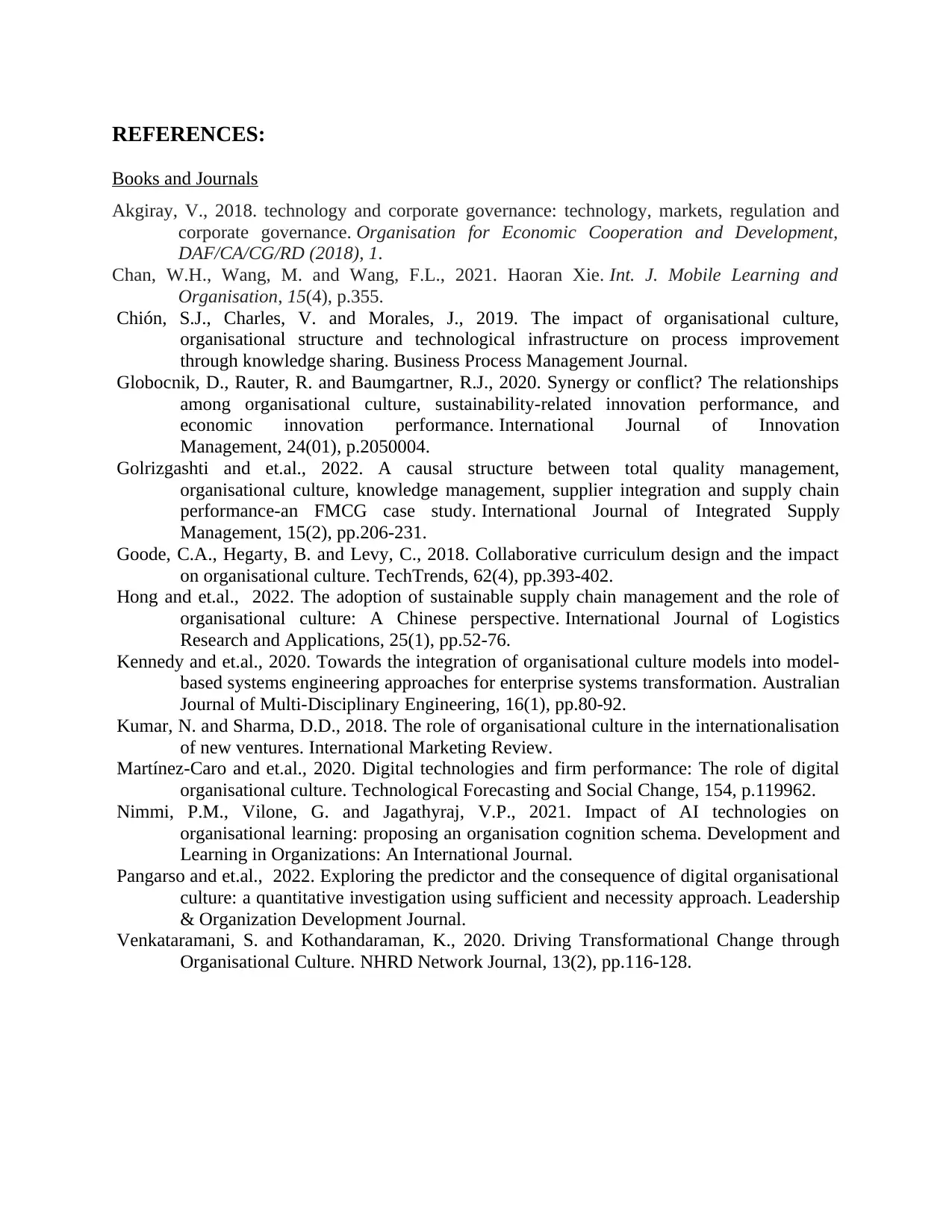
REFERENCES:
Books and Journals
Akgiray, V., 2018. technology and corporate governance: technology, markets, regulation and
corporate governance. Organisation for Economic Cooperation and Development,
DAF/CA/CG/RD (2018), 1.
Chan, W.H., Wang, M. and Wang, F.L., 2021. Haoran Xie. Int. J. Mobile Learning and
Organisation, 15(4), p.355.
Chión, S.J., Charles, V. and Morales, J., 2019. The impact of organisational culture,
organisational structure and technological infrastructure on process improvement
through knowledge sharing. Business Process Management Journal.
Globocnik, D., Rauter, R. and Baumgartner, R.J., 2020. Synergy or conflict? The relationships
among organisational culture, sustainability-related innovation performance, and
economic innovation performance. International Journal of Innovation
Management, 24(01), p.2050004.
Golrizgashti and et.al., 2022. A causal structure between total quality management,
organisational culture, knowledge management, supplier integration and supply chain
performance-an FMCG case study. International Journal of Integrated Supply
Management, 15(2), pp.206-231.
Goode, C.A., Hegarty, B. and Levy, C., 2018. Collaborative curriculum design and the impact
on organisational culture. TechTrends, 62(4), pp.393-402.
Hong and et.al., 2022. The adoption of sustainable supply chain management and the role of
organisational culture: A Chinese perspective. International Journal of Logistics
Research and Applications, 25(1), pp.52-76.
Kennedy and et.al., 2020. Towards the integration of organisational culture models into model-
based systems engineering approaches for enterprise systems transformation. Australian
Journal of Multi-Disciplinary Engineering, 16(1), pp.80-92.
Kumar, N. and Sharma, D.D., 2018. The role of organisational culture in the internationalisation
of new ventures. International Marketing Review.
Martínez-Caro and et.al., 2020. Digital technologies and firm performance: The role of digital
organisational culture. Technological Forecasting and Social Change, 154, p.119962.
Nimmi, P.M., Vilone, G. and Jagathyraj, V.P., 2021. Impact of AI technologies on
organisational learning: proposing an organisation cognition schema. Development and
Learning in Organizations: An International Journal.
Pangarso and et.al., 2022. Exploring the predictor and the consequence of digital organisational
culture: a quantitative investigation using sufficient and necessity approach. Leadership
& Organization Development Journal.
Venkataramani, S. and Kothandaraman, K., 2020. Driving Transformational Change through
Organisational Culture. NHRD Network Journal, 13(2), pp.116-128.
Books and Journals
Akgiray, V., 2018. technology and corporate governance: technology, markets, regulation and
corporate governance. Organisation for Economic Cooperation and Development,
DAF/CA/CG/RD (2018), 1.
Chan, W.H., Wang, M. and Wang, F.L., 2021. Haoran Xie. Int. J. Mobile Learning and
Organisation, 15(4), p.355.
Chión, S.J., Charles, V. and Morales, J., 2019. The impact of organisational culture,
organisational structure and technological infrastructure on process improvement
through knowledge sharing. Business Process Management Journal.
Globocnik, D., Rauter, R. and Baumgartner, R.J., 2020. Synergy or conflict? The relationships
among organisational culture, sustainability-related innovation performance, and
economic innovation performance. International Journal of Innovation
Management, 24(01), p.2050004.
Golrizgashti and et.al., 2022. A causal structure between total quality management,
organisational culture, knowledge management, supplier integration and supply chain
performance-an FMCG case study. International Journal of Integrated Supply
Management, 15(2), pp.206-231.
Goode, C.A., Hegarty, B. and Levy, C., 2018. Collaborative curriculum design and the impact
on organisational culture. TechTrends, 62(4), pp.393-402.
Hong and et.al., 2022. The adoption of sustainable supply chain management and the role of
organisational culture: A Chinese perspective. International Journal of Logistics
Research and Applications, 25(1), pp.52-76.
Kennedy and et.al., 2020. Towards the integration of organisational culture models into model-
based systems engineering approaches for enterprise systems transformation. Australian
Journal of Multi-Disciplinary Engineering, 16(1), pp.80-92.
Kumar, N. and Sharma, D.D., 2018. The role of organisational culture in the internationalisation
of new ventures. International Marketing Review.
Martínez-Caro and et.al., 2020. Digital technologies and firm performance: The role of digital
organisational culture. Technological Forecasting and Social Change, 154, p.119962.
Nimmi, P.M., Vilone, G. and Jagathyraj, V.P., 2021. Impact of AI technologies on
organisational learning: proposing an organisation cognition schema. Development and
Learning in Organizations: An International Journal.
Pangarso and et.al., 2022. Exploring the predictor and the consequence of digital organisational
culture: a quantitative investigation using sufficient and necessity approach. Leadership
& Organization Development Journal.
Venkataramani, S. and Kothandaraman, K., 2020. Driving Transformational Change through
Organisational Culture. NHRD Network Journal, 13(2), pp.116-128.
1 out of 11
Related Documents
Your All-in-One AI-Powered Toolkit for Academic Success.
+13062052269
info@desklib.com
Available 24*7 on WhatsApp / Email
![[object Object]](/_next/static/media/star-bottom.7253800d.svg)
Unlock your academic potential
Copyright © 2020–2025 A2Z Services. All Rights Reserved. Developed and managed by ZUCOL.
